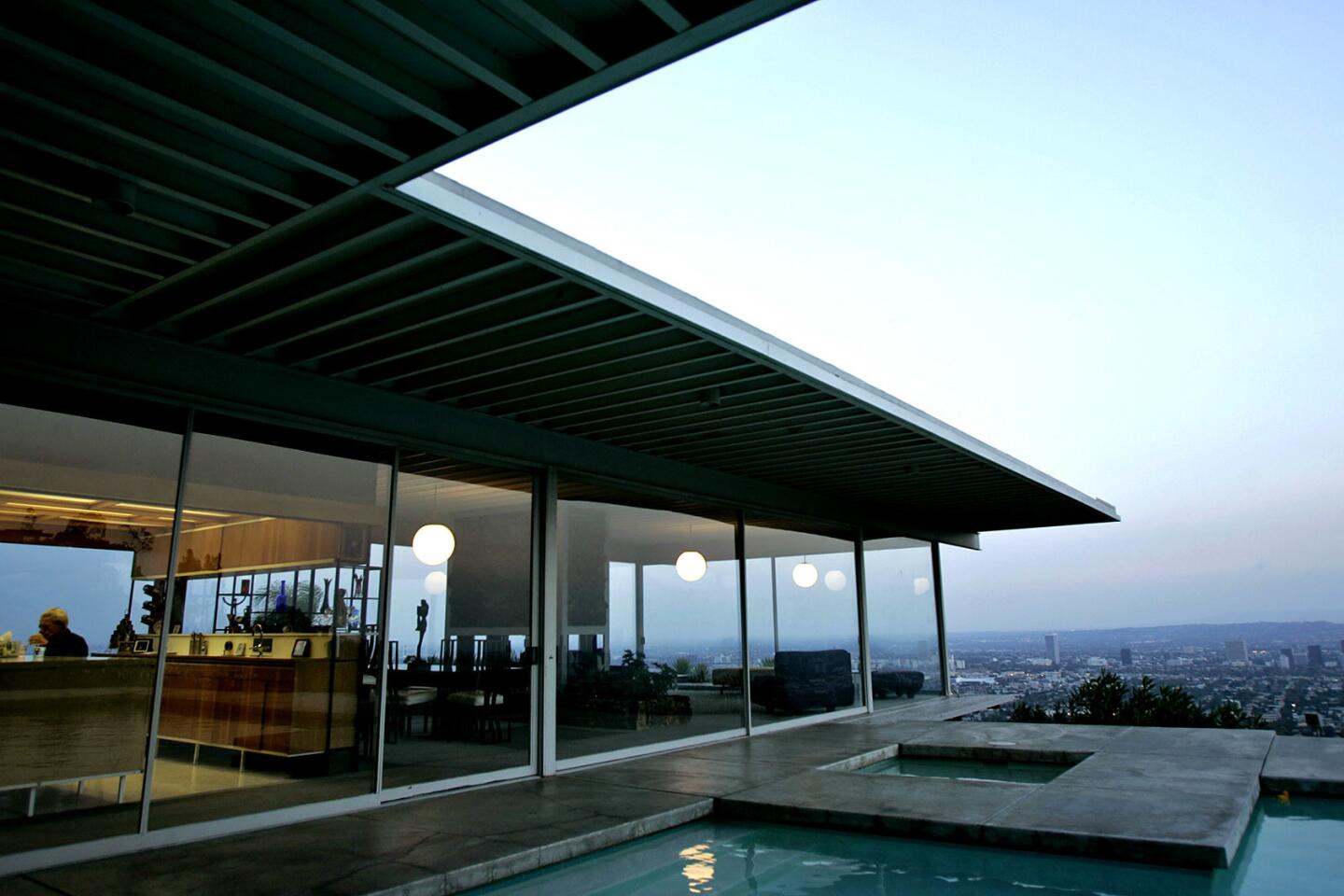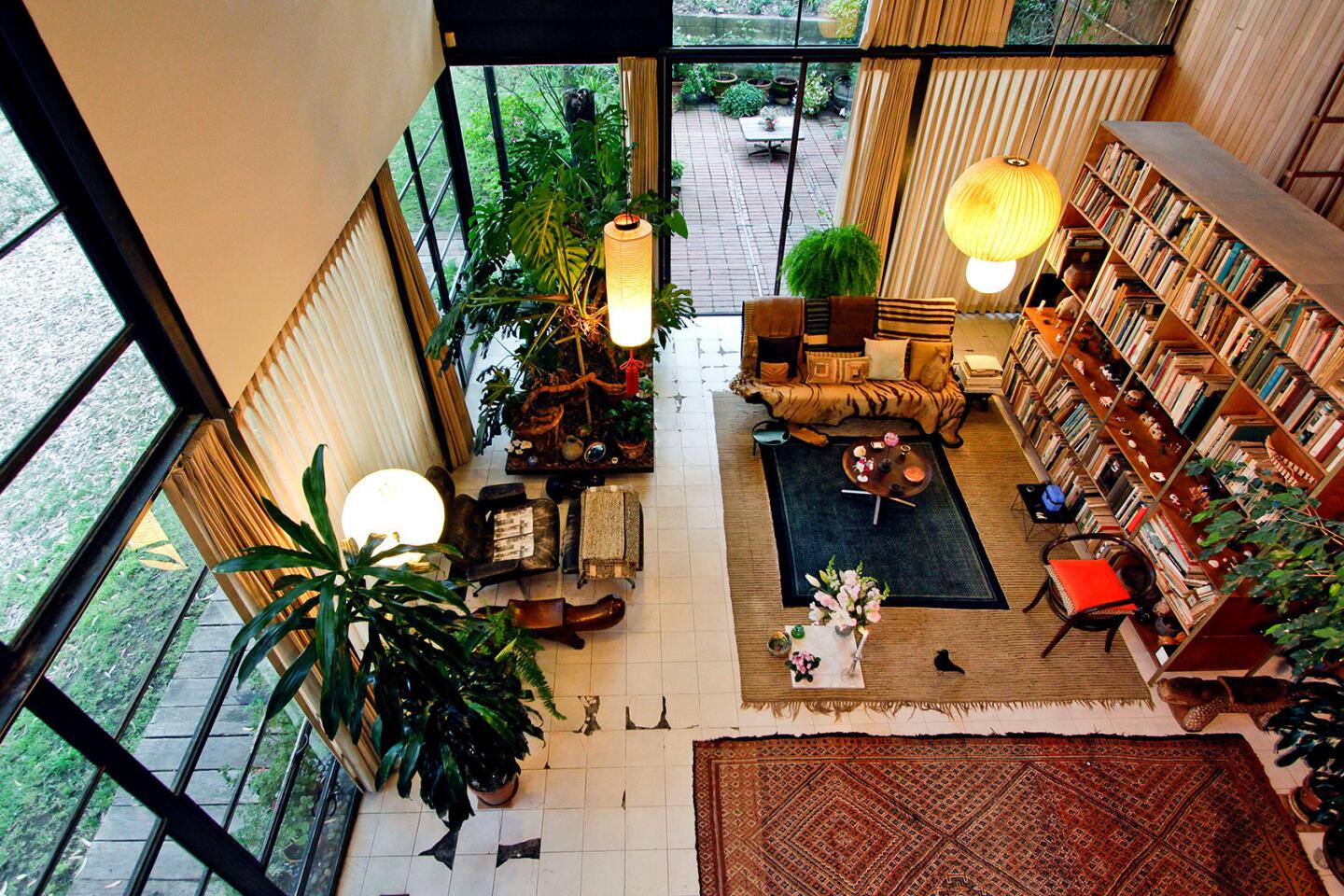Architectural Spotlight: Midcentury Modern, with its clean lines and simplicity, still has an edgy feel
- Share via
As World War II ended, advances in manufacturing, easing of wartime austerity and pent-up creativity among builders and architects led to a design explosion with its ground zero in Southern California: Midcentury Modern.
Known for its open floor plans, wide expanses of glass and indoor-outdoor living, the Midcentury Modern movement created homes that still seem avant-garde today, 50 to 70 years after they were built.
“It’s about simplicity, clean lines, getting away from ornamentation and molding, exposing the raw structure,” said Doug Kramer, a real estate agent who specializes in modern homes. “Obviously, the style is very much centered on a connection with the outdoors — the experience of just being able to slide open a wall of glass and be open to the outside.”
Kramer was a fan long before he bought and sold these houses — he’s lived in a midcentury Cliff May-designed home in Long Beach for 22 years and was hooked when he first saw the modernist design of the Tucson airport, his childhood hometown.
“The sense of space, the sense of openness, was one of the critical things I was looking for,” Kramer said.
World War II restrictions on building anything that didn’t advance the war effort created one of the biggest housing shortages in the country’s history, said Sian Winship, president of the Southern California chapter of the Society of Architectural Historians.
Once the war ended, service people in Southern California needed homes, and a coterie of progressive architects working in the area stepped in, eager to map out the future of home design.
“The concentration of new technologies, climate, postwar population boom and optimism made Southern California a fertile breeding ground for new architecture in the post-World War II era,” said a report from the National Park Service on the residential architecture of John Lautner.
One of the main engines of the movement was the ambitious Case Study House program, launched in January 1945 by Art & Architecture magazine editor John Entenza.
The program, which ran from 1945 to 1960, tapped leading architects of the day — mostly living in Los Angeles, where the magazine was based. Entenza said he believed advancements in home building would “expand considerably the definition of what we mean when we now say the word ‘house.’”
The project led to some of the most iconic examples of modernist architecture, captured in the pages of the magazine by photographer Julius Shulman and disseminated worldwide.
The best known is probably his shot of Case Study House No. 22, the Stahl House, a glass and steel box cantilevered over the Hollywood Hills. The viewer peers into one glass wall, through the house, and out another — sharing the panoramic view of L.A. city lights with the cocktail-dress-clad ladies inside.
Because of advances in manufacturing and construction and the use of industrial materials in home building, the Midcentury Modern houses didn’t need structural load-bearing walls with windows cut into them. Instead they featured long beams supported by wood or steel posts, which enable the massive walls of glass the style is known for.
The style, Winship said, “starts in earnest after the war, but you can see the seeds before,” in the work of Frank Lloyd Wright, Richard Neutra and others.
Real estate developer Joseph Eichler was still the treasurer of his family’s produce business when he briefly rented a Wright-designed home in Northern California during the war. The home’s openness and light inspired Eichler, and he launched a new career, building more than 11,000 modernist houses in Southern and Northern California.
But maybe the greatest concentration of Midcentury Modern homes can be found in Palm Springs, which had the same need for postwar housing among service people based there.
The modernist boom in the desert was also fueled by a market for vacation homes (thanks to peacetime affluence), and getaways for Hollywood stars and other well-to-do Angelenos.
Father-son builders George and Robert Alexander saw the void and filled it with about 2,500 modernist homes in the Palm Springs area.
“It’s the holy land for Midcentury Modern enthusiasts,” Kramer said.
Popularity of the style waned as the 1960s ended. But in 1989, a LACMA exhibition, Blueprints for Modern Living: History and Legacy of the Case Study Houses, rekindled interest in Midcentury Modern architecture. Their appearances in movies, TV and commercials — as eye-catching, offbeat settings — also generated intrigue.
“It’s definitely not a fad,” Kramer said. “It’s established, just like Craftsman, just like Spanish — it stands with all of that in the architectural history of Southern California.”
INFOBOX:
Style: Midcentury Modern
Features: Clean lines, little ornamentation, open floor plans, wide openings — between rooms and to the outdoors, post-and-beam construction, lots of glass, turning the focus from the street to the backyard.
Where to find them: Hollywood Hills, Palm Springs, Long Beach, Orange, Beverly Hills, Pacific Palisades, West Hollywood, North Hollywood, Thousand Oaks, Granada Hills, Villa Park
Some prominent architects: J.R. Davidson, Richard Neutra, Sumner Spaulding, Eero Saarinen, Charles Eames, William Wilson Wurster, Ralph Rapson, Pierre Koenig, Raphael Soriano, A. Quincy Jones, Edward Killingsworth, William Krisel, John Lautner, R.M. Schindler, Rodney Walker, Edward H. Fickett, Richard Dorman, Cliff May
MORE FROM HOT PROPERTY
Red Skelton’s former 600-acre horse ranch in Riverside seeks $6 million
Architect Richard Landry offers up his Century City condo for $3.69 million
Harry Styles chops half a million off his asking price in Hollywood Hills West
More to Read
Sign up for Essential California
The most important California stories and recommendations in your inbox every morning.
You may occasionally receive promotional content from the Los Angeles Times.








